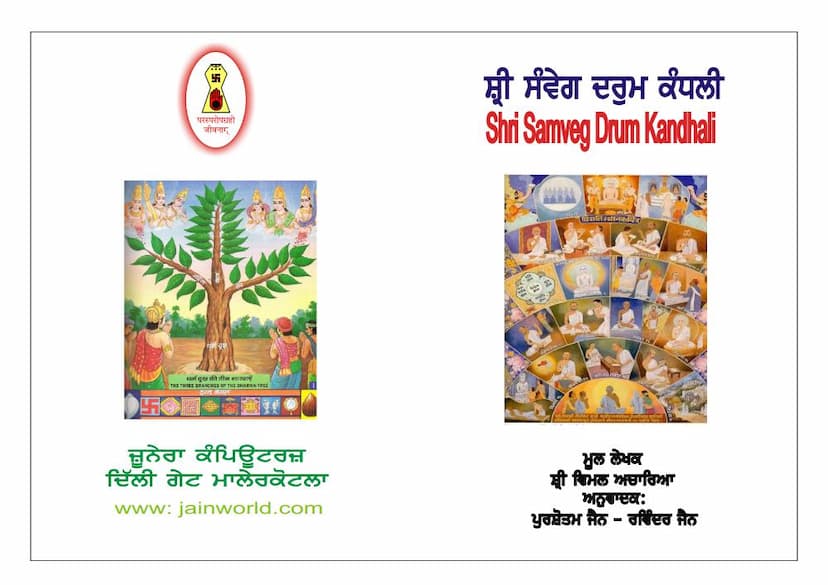Samved Drum Kandli
Added to library: September 2, 2025

Summary
Here is a comprehensive summary of the Jain text "Shri Samveg Drum Kandhali" in English, based on the provided pages:
Book Title: Shri Samveg Drum Kandhali (श्री संवेग द्रुम कंदली) Original Author: Shri Vimal Acharya (श्री विमल आचार्य) Translators: Purushottam Jain (पुरुषोत्तम जैन) and Ravindra Jain (रविंद्र जैन) Publisher: Purshottam Jain, Ravindra Jain (Published in commemoration of the 26th Mahavir Janma Kalyanak Shatabdi Sanyojak Samiti Punjab)
Overall Theme:
"Shri Samveg Drum Kandhali" is a Jain scripture that emphasizes the importance of vairagya (detachment or dispassion) as a crucial element for achieving samveg (a deep sense of introspection and spiritual inclination). The text, originally in Sanskrit with 50 verses (shlokas), aims to guide the reader towards renunciation (tyag) and spiritual liberation (moksha). It addresses the soul directly, using various poetic devices to convey profound spiritual insights.
Key Concepts and Structure:
-
Introduction and Dedication:
- The book is dedicated by Ravindra Jain to his "Dharma Brother" (fellow spiritual practitioner) Shri Purushottam Jain on the occasion of his 40th dedication anniversary.
- Ravindra Jain expresses deep gratitude to Purushottam Jain, highlighting their nearly 40-year partnership in translating and promoting Jain literature in Punjabi, a significant undertaking for Jain history.
- The translators acknowledge the blessing and support of numerous Jain Acharyas and Sadhvis, as well as institutions like Jain World and Sunil Desh Mani Sholapur.
-
Significance of Vairagya and Samveg:
- The introduction highlights that tyag (renunciation) and tapas (austerity) are central to Jainism.
- Vairagya (detachment) is essential for tyag, and samveg is another name for this detachment.
- Vairagya is a vital component of samyaktva (right faith/perception), which is indispensable for a complete life, whether for ascetics or householders.
- Samyaktva includes samyak darshan (right perception), samyak gyan (right knowledge), and samyak charitra (right conduct), as stated by Shri Umāsvāti in the Tattvartha Sutra.
-
The Author and the Text:
- Shri Vimal Acharya, also known as Shri Brahm Chandra, was a learned disciple of Shri Chakresh Suri.
- He was inspired by his disciple, Ravi, to compose this 50-verse text in Sanskrit.
- The book is described as an ancient and profound work that intricately explains the nature of the world and motivates readers towards renunciation.
- The author, in the concluding verse, urges readers to study this text, which is brighter than the moon and more tender than the heart of a lotus, if they desire the path of liberation, the happiness of contentment, aversion to worldly pleasures, and the awakening of self-love.
-
Content of the Verses (Shlokas): The verses collectively guide the soul away from worldly attachments and towards spiritual purification. Key themes addressed include:
- Overcoming Negative Emotions: Several verses focus on conquering anger (krodh), pride (maan), greed (lobh), illusion (maya), and lust (kam). They describe the destructive nature of these emotions and the importance of virtues like forgiveness, humility, simplicity, and contentment.
- The Impermanence of the World: The text repeatedly emphasizes that the world is transient and ultimately leads to suffering. It advises detachment from worldly possessions, relationships, and sensory pleasures.
- The Importance of Right Conduct: The verses advocate for the practice of the ten virtues (dharma), including forbearance, humility, straightness, purity, renunciation, penance, self-control, truth, non-possession, and celibacy.
- The Body and its Limitations: The body is described as impure, temporary, and a source of suffering. The text urges against excessive attachment to it and highlights that it will not accompany the soul in the afterlife.
- Spiritual Practices: The verses promote meditation, introspection, and the practice of tapas (austerity) as means to purify the soul and overcome the cycle of birth and death.
- The Dangers of Sensory Indulgences: The allure of women and worldly pleasures is depicted as a trap that distracts the soul from its true purpose, leading to further suffering.
- The Role of the Guru: The text implicitly stresses the importance of spiritual guidance in understanding and following the path of liberation.
- The Nature of Maya (Illusion): The overwhelming power of maya that distorts perception and leads to attachment to the non-eternal is highlighted.
- The True Nature of Happiness: True happiness is found not in external pleasures but in inner contentment and detachment.
- The Value of Human Birth: The rarity and significance of human birth, which offers the opportunity for spiritual progress, is emphasized.
-
Concluding Advice: The final verses reiterate the impermanence of life and the inevitability of death. They urge the reader to investigate the self (atma tattva) and seek the ultimate truth, rather than being deluded by worldly pursuits and sensory desires. The text concludes with a strong plea to control the senses, meditate on the divine light, and strive for eternal bliss.
In essence, "Shri Samveg Drum Kandhali" is a spiritual guide that uses evocative language to awaken the reader to the realities of existence, the pitfalls of worldly attachments, and the path towards spiritual liberation through detachment, introspection, and righteous conduct.